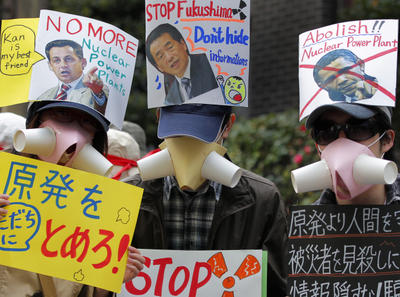A week or so ago, a Mainichi Newspaper poll suggested that 74 per cent of Japanese want to gradually phase out nuclear power completely. Last week, another poll found that only 5 per cent of Japanese had confidence in the safe operation of the nation’s nuclear power plants, while 60 per cent had little or no confidence in them. This poll suggests 55 per cent want to reduce the number of atomic power plants, a smaller proportion than the Mainichi poll but a comfortable majority of those polled. In Japan a few weeks back, I was stunned at the dramatic shift-around in Japanese attitudes to nuclear energy and the preparedness of quite conservative thinkers to contemplate a Japanese energy future without it.
Only 12 of Japan’s 54 nuclear power plants are currently in operation. The rest are either off-line for regular maintenance or shut down for stress-testing (using more stringent tests than previously) after the Fukushima accident. Ramping up the utilisation rates of non-nuclear capacity, the good fortune of a cooler summer and re-shuffling industrial production schedules have together avoided serious short term power disruptions. But these are band-aid solutions to Japan’s longer term energy problems.
In this week’s lead essay, Dick Samuels notes that after the March 11 crisis, former Prime Minister Kan announced plans for a bottom-up review of Japan’s nuclear-centred Basic Energy Plan. Constructed by the Ministry of Economy, Trade and Industry (METI) with considerable input from TEPCO and the other private power utilities, this plan called for the construction of fourteen additional nuclear power plants by 2030. Kan’s announcement was unequivocal and well received: Japan must ‘start from scratch’ on a new national energy policy.
With the growth of hostility towards nuclear power, Japanese energy policy is now in a state of considerable disarray. There are no clear ideas about how the looming shortages in energy supply will be filled without re-starting of Japan’s currently offline nuclear power plants. There are no clear ideas about how the gap in energy needs would be covered if nuclear power were to be phased out over the longer term.
Japan’s new prime minister, Yoshihiko Noda, is not antipathetic to nuclear in the same way as his predecessor. His immediate task will be to persuade the Japanese public, and the local government officials who have direct responsibility to their communities, that it is safe to re-start the reactors that have been shut down for testing — a process that nonetheless won’t be complete until the end of the year. Noda wrote as much in an article which appeared in Bungei Shunju earlier this month. If he fails to act quickly, all 54 of Japan’s nuclear reactors could be offline by May next year in the normal schedule of plant maintenance.
Whether Noda can convince the Japanese public that maintaining the same level of nuclear power capacity, let alone increasing it, is desirable in the longer term is another question altogether. The Ministry of Economy Trade and Industry (METI) calculates that a complete nuclear shutdown would add US$40 billion directly to energy costs, not to mention what it would add to carbon emissions.
Can there be a speedy transition to renewable energy sources in Japan?
It will not be easy, although, the argument now runs, clarity on the goal (for example a long term — 30 or 40 year — phase-out of nuclear) would provide the incentive to develop options and get costs down. The problem is that there is not much clarity on anything right now. Last week, the Diet introduced a scheme that will subsidise electricity produced by five types of green energy, but investors will have to wait for a panel to determine details of the tariffs that will apply to solar, wind, and other green sources of power. Solar and wind currently account for less than 3 per cent of Japan’s energy capacity. The hope is that energy supplied from these sources will quintuple in ten years, but that solves less than half the problem.
Meanwhile LNG imports are surging, and expected to rise 12.2 per cent over the year to 78.6 million tons in 2011 and 81.6 million tons in 2012. Ramping up LNG use has its problems as port handling and processing capacities are likely to reach their limit with volumes like this being imported.
As Samuels says, ‘even if the changes in Japan’s energy policies are less sweeping than those Prime Minister Kan proposed, it will be difficult for his successors, new Prime Minister Noda included, to return to the energy policy status quo ante. Energy policy, and nuclear power in particular, will be an important electoral issue in Japan for a long time to come’.
Peter Drysdale

